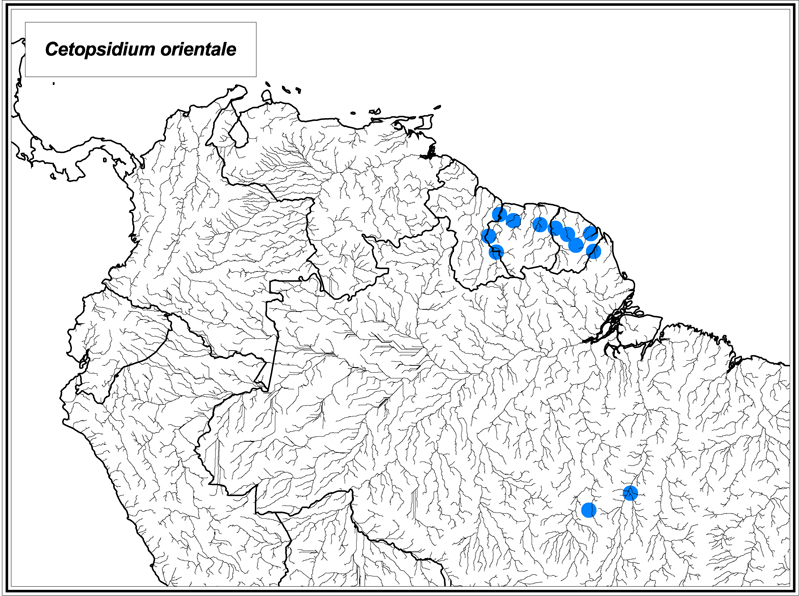
Reproduced from Vari, Ferraris and de Pinna (2005).
Cetopsidium orientale (Vari, Ferraris & Keith, 2003)
Identification: Cetopsidium orientale differs from C. ferreirai in the degree of development of the first rays of the dorsal and pectoral fins (with distal filaments present in presumed males as indicated by the possession of a distinctly convex anal-fin margin versus absent in such specimens, respectively), the relative depth of the body (0.21-0.23 of SL versus 0.18-0.20 of SL, respectively), the overall coloration pattern (dark pigmentation widely distributed over dorsal and lateral of body versus limited dark pigmentation situated primarily along middorsal region of body, respectively), and to a degree in the number of total vertebrae (37 to 39 versus 39 or 40, respectively). Cetopsidium orientale differs from C. minutum in the length of the pelvic fin (reaching posteriorly to the anterior margin of the vent versus to the anal-fin origin, respectively), the relative depth of the body (0.21-0.23 of SL versus 0.17-0.19 of SL, respectively), and in the length of the pectoral fin (tip falling distinctly short of the vertical through the pelvic-fin insertion versus reaching that line, respectively). Cetopsidium orientale differs from C. morenoi in the alignment of the dorsal and ventral profiles of the portion of the body posterior of the terminus of the base of dorsal fin (running in parallel versus converging posteriorly, respectively), in the degree of development and extent of the dark pigmentation on the body (limited dark pigmentation extending onto the base of the anal fin in at least some specimens and without dark blotch of pigmentation at the base of the dorsal fin versus extensive dark pigmentation falling short of the base of the anal fin and with a semicircular dark spot present at the base of the dorsal fin, respectively), the distribution of dark pigmentation on the rayed portion of the caudal fin (present on at least basal one-half of fin versus absent, respectively), the form of the dark pigmentation on the middorsal portion of the body posterior terminus of the base of dorsal fin (distinct stripe present versus absent, respectively), and the degree of development of dark pigmentation on the lower jaw (pigmentation in form of a broad band versus consisting of single, often incomplete, row of chromatophores, respectively). Cetopsidium orientale differs from C. pemon in its overall coloration (large, stellate, dark chromatophores densely covering dorsal and lateral surfaces of the head and body versus the small, point-like chromatophores scattered over the dorsal and lateral surfaces of the head and body, respectively), in the alignment of the dorsal and ventral profiles of the portion of the body posterior of the base of the dorsal fin (running in parallel versus converging posteriorly, respectively), and in the inclination of the predorsal region of the body and head (slightly inclined versus distinctly inclined, respectively). Cetopsidium orientale differs from C. roae in the position of the vent (proximate to the base of the anterior most anal-fin ray versus distinctly separated from that structure, respectively) and in the overall coloration (large, stellate, dark chromatophores densely covering the dorsal and lateral surfaces of the head and body versus the small, point-like chromatophores scattered over the dorsal and lateral surfaces of the head and body, respectively). Maximum size: 58 mm SL.
Range: Cetopsidium orientale is known from the coastal rivers of Suriname and French Guiana in the region from the Corantijn River along the border between Suriname and Guyana to the Fleuve Oyapock-Rio Oiapoque along the French Guiana-Brazil border. Given the presence of this species in the Surinamese tributaries of the Corantijn River, it is likely that is also occurs in the left bank tributaries to that river draining from Guyana. Similarly it is likely that the species also occurs in the portions of the Rio Oiapoque basin within Brazil. Material tentatively identified as this species originated in the Rio Tocantins and Rio Xingu.
Information from Vari, R. P., C. J. Ferraris Jr. & M. C. C. de Pinna. 2005. The Neotropical whale catfishes (Siluriformes: Cetopsidae: Cetopsinae), a revisionary study. Neotropical Ichthyology 3:127-238.
